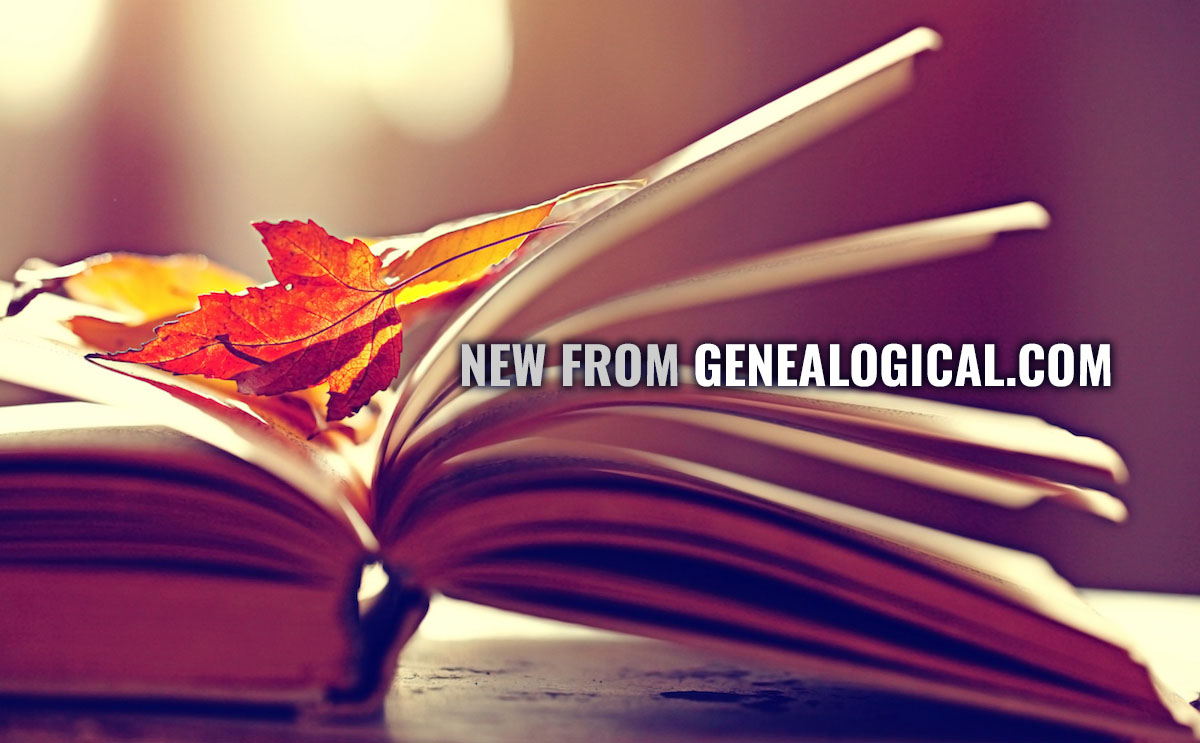
Last week we wrote about a major new resource for Connecticut genealogy, Linda MacLachlan’s Finding Early Connecticut Vital Records: The Barbour Index and Beyond. MacLachlan shows that Barbour and his staff omitted any number of sources researchers should know about, and her book is the complete inventory of Connecticut vital records.
Besides Ms. MacLachlan’s groundbreaking publication, here are a number of other new books we are pleased to tell you about this month. We’ve summarized them below, but you can read full descriptions by clicking on the links embedded with the titles.
- ABSTRACT OF THE DEBT BOOKS OF THE PROVINCIAL LAND OFFICE OF MARYLAND.
BALTIMORE COUNTY
By V. L. Skinner
Volume I . Calvert Papers, 1750: Liber 5: 1754, 1755 & 1756
Volume 2. Liber 5: 1757; Liber 6: 1758, 1759, 1760
Volume 3. Liber 6: 1761; Liber 7: 1762, 1763, 1764
Volume 4. Liber 7: 1765; Liber 8: 1766, 1768
Volume 5. Liber 9: 1769, 1770, 1771
Maryland’s Provincial Debt Books contain lists of persons owning land with the names and rents of each tract that he or she owned. Since 2013, distinguished Maryland genealogist V.L. Skinner has painstakingly abstracted the contents of all extant Debt Books, county by county. These five new volumes pertaining to Baltimore County are the final ones in the series, bringing the grand total of books to 38. Earlier counties covered by Mr. Skinner include Anne Arundel, Calvert, Cecil, Charles, Dorchester, Frederick, Kent, Prince George’s, Queen Anne’s, Somerset, St. Mary’s, Talbot, and Worcester. To see a complete list of volumes, click the button below.
- Civil War Medical Practices
Susan Provost Beller
The state of American medical care in 1861 was simply incapable of handling the volume and severity of injuries soldiers sustained during the Civil War. More combatants died from infections and disease than were killed outright on the battlefield. Amputation was the surgery of first resort for injuries to arms and legs. At the same time, the sheer scale of the Civil War afforded doctors and nurses the opportunity to revolutionize certain aspects of medical care. The use of anesthesia changed surgery forever. The surgical use of resection or excision was invented during the Civil War. Hospital design was changed because of the war, and the entirely new profession of nursing opened up opportunities for women outside the home.
What we would regard today as the butchery of Civil War medical has rarely been told as well, or as succinctly, as in this book by Susan Beller. In scarcely 100 amply illustrated pages, Ms. Beller paints a vivid picture of Civil War medicine. Her chapters cover medical knowledge of the 1860s; deaths from disease and wounds; doctors, nurses and other medical staff; medical instruments; anesthesia; surgery; hospitals; recovery and death; and other aspects of the aftermath of combat. Are you a Civil War buff? Did your ancestor take part in this the deadliest conflict in American history? Does the history of medicine interest you? Either way, you will want to own a copy of this stellar volume.
- THE PEOPLE OF JAMAICA, 1655-1855
Dr. David Dobson
While colonial Jamaica was settled by enormous numbers of African slaves to work its sugar cane, Jamaica was also a destination for prisoners of war, rebels, and criminals transported in chains, to be sold as servants to the planters there. Many artisans emigrated from English ports, notably Bristol and London, as indentured servants to Jamaica, and were employed by merchants and planters who paid for their passage and maintenance for a few years before the servants were free to settle. For his latest volume, Dr. Dobson identifies about 2,000 Euro-Jamaicans by name, a date, one other point of specificity, and the source. In many instances we also learn the individual’s country or locality of origin, names and relationships of kin, vessel traveled upon, occupation, college attended, or other identifying features.
- Genealogy at a Glance. Irish Genealogy Research. 2nd Edition
Brian Mitchell
This is the best overview of Irish genealogy available. Since the first edition of this guide was published, many more key record sources have been digitized and made available online, including Irish civil records of births, marriages, and deaths; Irish parish registers; and cemetery records. In this second edition, Mitchell discusses how to access these newly available resources, and gives the most current information on record repositories, genealogy websites, and reference materials that will help further your research.
- THE PEOPLE OF DERRY CITY, 1930
Extracted from the Derry Almanac and Directory
Brian Mitchell
By 1930, despite a number of economic setbacks, Derry still retained its maritime importance as both a gateway to North West Ireland (i.e. counties Derry, Donegal and Tyrone) and as a corridor across the Atlantic linking Western Europe with North America. The port’s annual Derry Almanac and Directory contained a ‘Street Directory’ where heads of households were identified against their street address in Derry city. The Street Directory represented the closest “census substitute” for Derry city for the years 1912-1936, for which period no official enumerations exist. For genealogists, the Derry Almanac and Directory of 1930 names 9,084 heads of household and family businesses in Derry city. This list of inhabitants, in alphabetical order by surname, contains these 5 fields: Surname of Head of Household, First Name of Head of Household, Street Address, House Number, and Page Number of the listing. It’s a godsend for genealogists of Northern Ireland.




